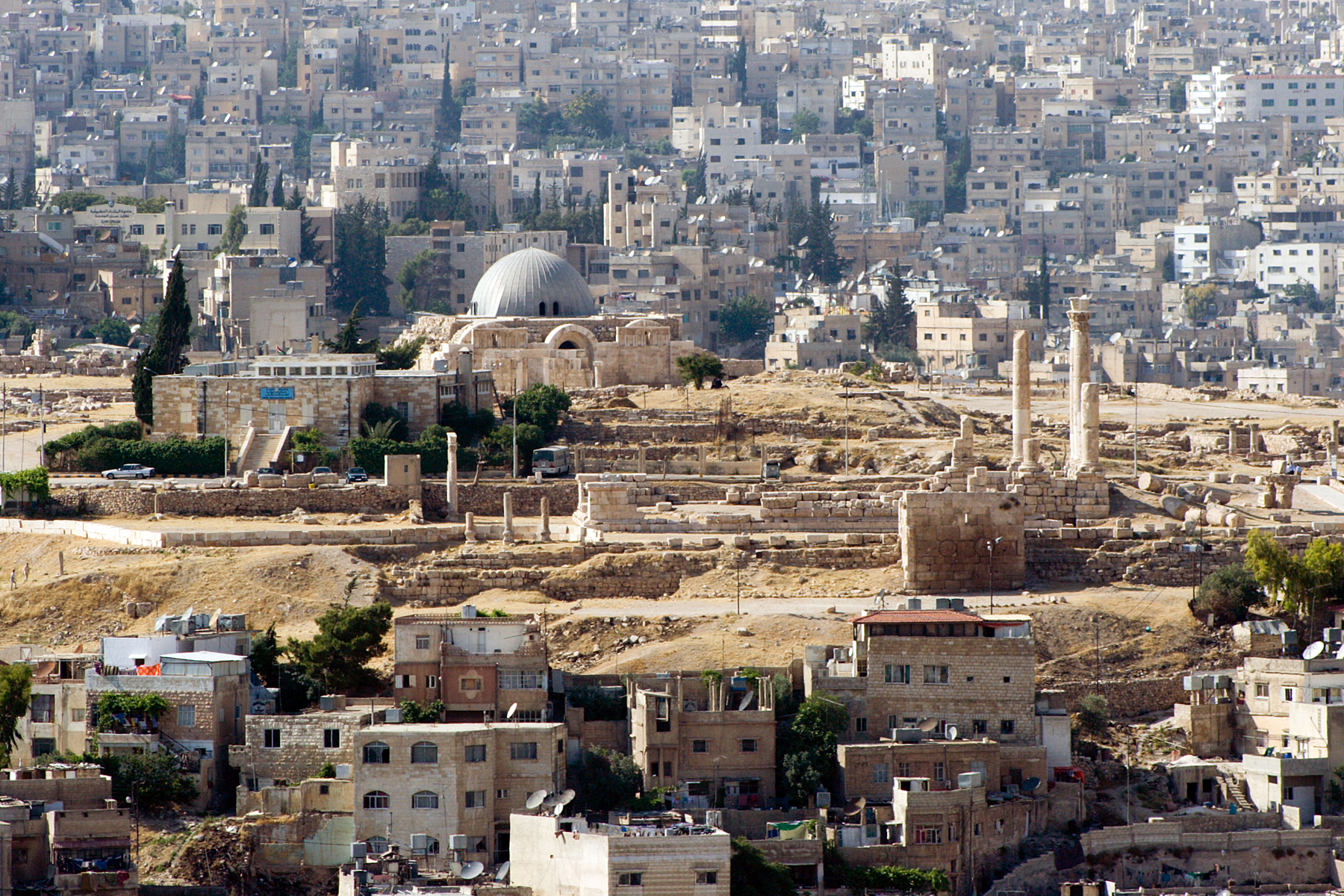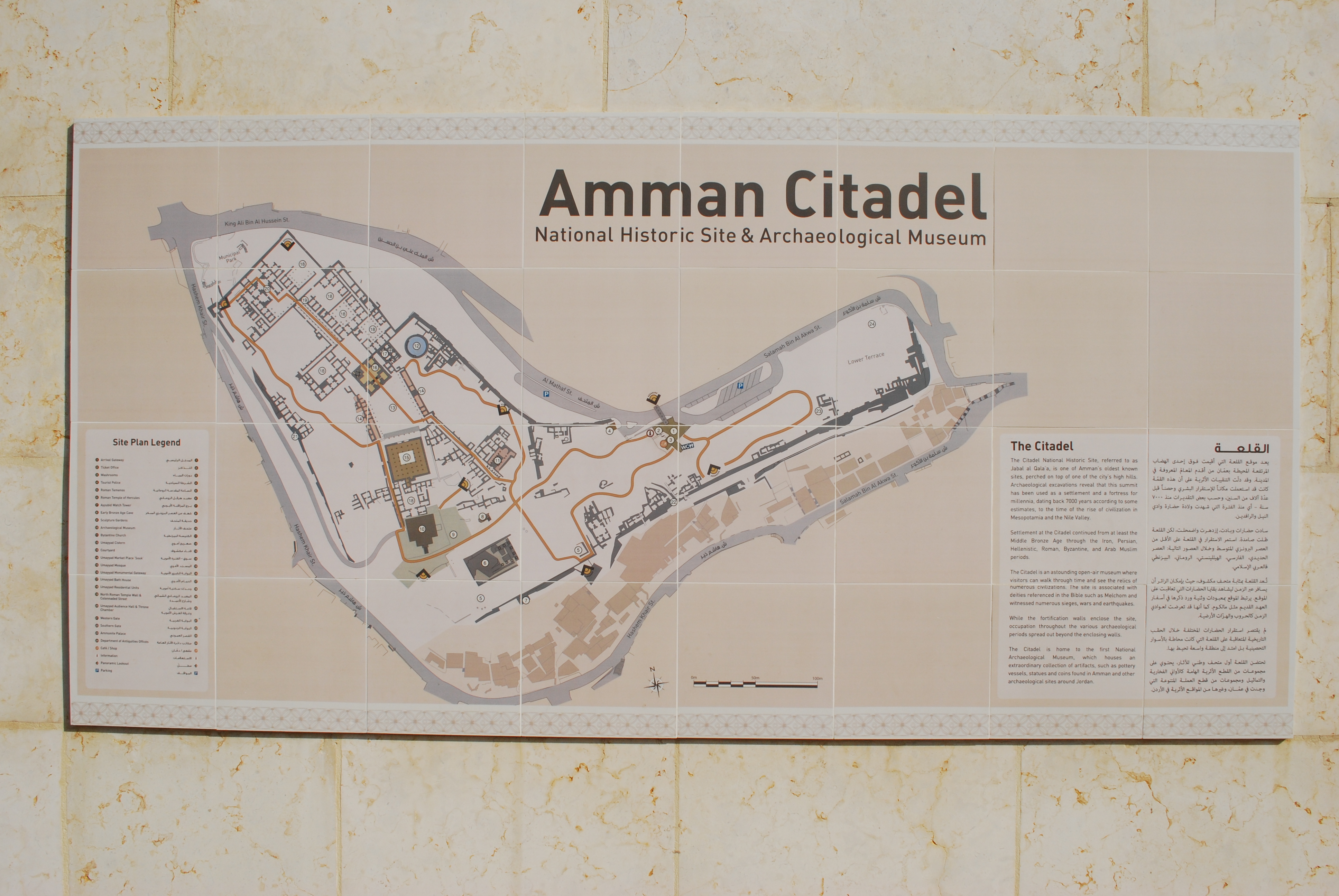Amman Citadel on:
[Wikipedia]
[Google]
[Amazon]


 The Amman Citadel ( ar, جبل القلعة, Jabal Al-Qal'a) is an
The Amman Citadel ( ar, جبل القلعة, Jabal Al-Qal'a) is an
here
)

archeological site
An archaeological site is a place (or group of physical sites) in which evidence of past activity is preserved (either prehistoric or historic or contemporary), and which has been, or may be, investigated using the discipline of archaeology an ...
at the center of downtown Amman
Amman (; ar, عَمَّان, ' ; Ammonite: 𐤓𐤁𐤕 𐤏𐤌𐤍 ''Rabat ʻAmān'') is the capital and largest city of Jordan, and the country's economic, political, and cultural center. With a population of 4,061,150 as of 2021, Amman is ...
, the capital of Jordan
Jordan ( ar, الأردن; tr. ' ), officially the Hashemite Kingdom of Jordan,; tr. ' is a country in Western Asia. It is situated at the crossroads of Asia, Africa, and Europe, within the Levant region, on the East Bank of the Jordan Rive ...
. The L-shaped hill is one of the seven hills (''jabals'') that originally made up Amman.
The Citadel has a long history of occupation by many great civilizations.Najjar, M. "Amman Citadel Temple of Hercules Excavations Preliminary Report." ''Syria'' 70 (1993). pp. 220-225. Evidence of inhabitance since the Neolithic period
The Neolithic period, or New Stone Age, is an Old World archaeological period and the final division of the Stone Age. It saw the Neolithic Revolution, a wide-ranging set of developments that appear to have arisen independently in several parts ...
has been found and the hill was fortified during the Bronze Age
The Bronze Age is a historic period, lasting approximately from 3300 BC to 1200 BC, characterized by the use of bronze, the presence of writing in some areas, and other early features of urban civilization. The Bronze Age is the second pri ...
(1800 BCE). The hill became the capital of the Kingdom of Ammon
Ammon (Ammonite: 𐤏𐤌𐤍 ''ʻAmān''; he, עַמּוֹן ''ʻAmmōn''; ar, عمّون, ʻAmmūn) was an ancient Semitic-speaking nation occupying the east of the Jordan River, between the torrent valleys of Arnon and Jabbok, in ...
sometime after 1200 BCE. It later came under the sway of empires such as the Neo-Assyrian Empire
The Neo-Assyrian Empire was the fourth and penultimate stage of ancient Assyrian history and the final and greatest phase of Assyria as an independent state. Beginning with the accession of Adad-nirari II in 911 BC, the Neo-Assyrian Empire grew ...
(8th century BCE), Neo-Babylonian Empire
The Neo-Babylonian Empire or Second Babylonian Empire, historically known as the Chaldean Empire, was the last polity ruled by monarchs native to Mesopotamia. Beginning with the coronation of Nabopolassar as the King of Babylon in 626 BC and bei ...
(6th century BC), the Ptolemies
The Ptolemaic dynasty (; grc, Πτολεμαῖοι, ''Ptolemaioi''), sometimes referred to as the Lagid dynasty (Λαγίδαι, ''Lagidae;'' after Ptolemy I's father, Lagus), was a Macedonian Greek royal dynasty which ruled the Ptolemaic ...
, the Seleucids
The Seleucid Empire (; grc, Βασιλεία τῶν Σελευκιδῶν, ''Basileía tōn Seleukidōn'') was a Greek state in West Asia that existed during the Hellenistic period from 312 BC to 63 BC. The Seleucid Empire was founded by the M ...
(3rd century BCE), Romans
Roman or Romans most often refers to:
*Rome, the capital city of Italy
* Ancient Rome, Roman civilization from 8th century BC to 5th century AD
*Roman people, the people of ancient Rome
*''Epistle to the Romans'', shortened to ''Romans'', a lette ...
(1st century BCE), Byzantines (3rd century CE) and the Umayyads (7th century CE). After the Umayyads, came a period of decline and for much of the time until 1878 as the former city became an abandoned pile of ruins only sporadically used by Bedouin
The Bedouin, Beduin, or Bedu (; , singular ) are nomadic Arabs, Arab tribes who have historically inhabited the desert regions in the Arabian Peninsula, North Africa, the Levant, and Mesopotamia. The Bedouin originated in the Syrian Desert ...
s and seasonal farmers. Despite this gap, the Citadel of Amman is considered to be among the world's oldest continuously inhabited places.
Most of the structures still visible at the site are from the Roman, Byzantine, and Umayyad periods. The major remains at the site are the Temple of Hercules, a Byzantine church, and the Umayyad Palace
The Umayyad Palace ( ar, القصر الأموي) is a large palatial complex from the Umayyad period, located on the Citadel Hill (Jabal al-Qal'a) of Amman, Jordan. Built during the first half of the 8th century, it is now largely ruined, w ...
. The Jordan Archaeological Museum
The Jordan Archaeological Museum is located in the Citadel of Amman, Jordan. Built in 1951, it presents artifacts from archaeological sites in Jordan, dating from prehistoric times to the 15th century. The collections are arranged in chronological ...
was built on the hill in 1951. Though the fortification walls enclose the heart of the site, the ancient periods of occupation covered large areas. Historic structures, tombs, arches, walls and stairs have no modern borders, and therefore there is considerable archaeological potential at this site, as well as in surrounding lands, and throughout Amman. Archaeologists have been working at the site since the 1920s, including Italian, British, French, Spanish, and Jordanian projects, but a great part of the Citadel remains unexcavated.
History
Excavations have uncovered signs of human occupation from as far back as theMiddle Bronze Age
The Bronze Age is a historic period, lasting approximately from 3300 BC to 1200 BC, characterized by the use of bronze, the presence of writing in some areas, and other early features of urban civilization. The Bronze Age is the second pr ...
(1650-1550 BCE) in the form of a tomb that held pottery and scarab seals. During the Iron Age, the Citadel was the site of the capital of the Ammon
Ammon (Ammonite: 𐤏𐤌𐤍 ''ʻAmān''; he, עַמּוֹן ''ʻAmmōn''; ar, عمّون, ʻAmmūn) was an ancient Semitic-speaking nation occupying the east of the Jordan River, between the torrent valleys of Arnon and Jabbok, in ...
ites, which was known as "Rabbah" or "Rabbath Ammon". The Amman Citadel Inscription comes from this period, and is considered to be the oldest known inscription in the Ammonite language
Ammonite is the extinct Canaanite language of the Ammonite people mentioned in the Bible, who used to live in modern-day Jordan, and after whom its capital Amman is named. Only fragments of their language survive - chiefly the 9th century BC A ...
, written in the Phoenician Alphabet
The Phoenician alphabet is an alphabet (more specifically, an abjad) known in modern times from the Canaanite and Aramaic inscriptions found across the Mediterranean region. The name comes from the Phoenician civilization.
The Phoenician al ...
. From the Hellenistic Period
In Classical antiquity, the Hellenistic period covers the time in Mediterranean history after Classical Greece, between the death of Alexander the Great in 323 BC and the emergence of the Roman Empire, as signified by the Battle of Actium in ...
, there were not many architectural changes, but pottery provides evidence for their occupation. The site became Roman around 30 BCE, and eventually came under Muslim rule in 661 CE.Kadhim, M. B., and Y. Rajjal. "Amman" ''Cities'' 5.4 (1988). pp. 318-325. The Citadel declined in importance under Ayyubid
The Ayyubid dynasty ( ar, الأيوبيون '; ) was the founding dynasty of the medieval Sultanate of Egypt established by Saladin in 1171, following his abolition of the Fatimid Caliphate of Egypt. A Sunni Muslim of Kurdish origin, Saladin ...
rule in the 13th century, but a watchtower
A watchtower or watch tower is a type of fortification used in many parts of the world. It differs from a regular tower in that its primary use is military and from a turret in that it is usually a freestanding structure. Its main purpose is to ...
was added to the site during this period.
Main structures
*The Roman Temple of Hercules *TheUmayyad Palace
The Umayyad Palace ( ar, القصر الأموي) is a large palatial complex from the Umayyad period, located on the Citadel Hill (Jabal al-Qal'a) of Amman, Jordan. Built during the first half of the 8th century, it is now largely ruined, w ...
, mosque, and water cistern
*The Byzantine church (ESE of the Umayyad mosque)
*The Ayyubid watchtower
Temple of Hercules
The Temple of Hercules dates to the Roman period in the 2nd century CE.Umayyad palace and mosque
During theUmayyad
The Umayyad Caliphate (661–750 CE; , ; ar, ٱلْخِلَافَة ٱلْأُمَوِيَّة, al-Khilāfah al-ʾUmawīyah) was the second of the four major caliphates established after the death of Muhammad. The caliphate was ruled by the ...
period (AD 661-750), a palace structure, known in Arabic as ''al-Qasr'' (''القصر''), was built at the Citadel. The Umayyad Palace was probably used as an administrative building or the residence of an Umayyad official. The palace draws on Byzantine
The Byzantine Empire, also referred to as the Eastern Roman Empire or Byzantium, was the continuation of the Roman Empire primarily in its eastern provinces during Late Antiquity and the Middle Ages, when its capital city was Constantinopl ...
architectural patterns. For example, the entrance hall is built in the shape of a Greek cross
The Christian cross, with or without a figure of Christ included, is the main religious symbol of Christianity. A cross with a figure of Christ affixed to it is termed a ''crucifix'' and the figure is often referred to as the ''corpus'' (La ...
. The palace may have been built on top of an existing Byzantine structure in this shape. There is a huge water reservoir dug into the ground adjacent to the palace.
The Amman Citadel Mosque is an example of early mosques that imitated the Persian-style ''apadana
Apadana ( peo, 𐎠𐎱𐎭𐎠𐎴) is a large hypostyle hall in Persepolis, Iran. It belongs to the oldest building phase of the city of Persepolis, in the first half of the 6th century BC, as part of the original design by Darius the Gr ...
'' hall, characterised by a "forest of columns"; these mosques are normally found only in Persia
Iran, officially the Islamic Republic of Iran, and also called Persia, is a country located in Western Asia. It is bordered by Iraq and Turkey to the west, by Azerbaijan and Armenia to the northwest, by the Caspian Sea and Turkmeni ...
and Mesopotamia
Mesopotamia ''Mesopotamíā''; ar, بِلَاد ٱلرَّافِدَيْن or ; syc, ܐܪܡ ܢܗܪ̈ܝܢ, or , ) is a historical region of Western Asia situated within the Tigris–Euphrates river system, in the northern part of the ...
(Iraq
Iraq,; ku, عێراق, translit=Êraq officially the Republic of Iraq, '; ku, کۆماری عێراق, translit=Komarî Êraq is a country in Western Asia. It is bordered by Turkey to Iraq–Turkey border, the north, Iran to Iran–Iraq ...
). (At Brill sehere
)
Tourism
Starting in 1995-6, the Ministry of Tourism and Antiquities of Jordan in partnership withUSAID
The United States Agency for International Development (USAID) is an independent agency of the U.S. federal government that is primarily responsible for administering civilian foreign aid and development assistance. With a budget of over $27 bi ...
began a project to conserve and restore this site to benefit tourists and the local community. The Amman Citadel is also the site of Jordan Archaeological Museum
The Jordan Archaeological Museum is located in the Citadel of Amman, Jordan. Built in 1951, it presents artifacts from archaeological sites in Jordan, dating from prehistoric times to the 15th century. The collections are arranged in chronological ...
, which is home to a collection of artifacts from the Citadel and other Jordanian historic sites.
References
External links
* {{DEFAULTSORT:Amman Citadel Buildings and structures in Amman Archaeological sites in Jordan Tourist attractions in Amman Tells (archaeology)